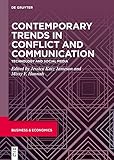Emerging Trends in Conflict Management. Contemporary Trends in Conflict and Communication : Technology and Social Media / ed. by Jessica Katz Jameson, Missy F. Hannah.
Material type: TextSeries: Emerging Trends in Conflict Management ; Volume IPublisher: Berlin ; Boston : De Gruyter, [2022]Copyright date: ©2022Description: 1 online resource (XIV, 288 p.)Content type:
TextSeries: Emerging Trends in Conflict Management ; Volume IPublisher: Berlin ; Boston : De Gruyter, [2022]Copyright date: ©2022Description: 1 online resource (XIV, 288 p.)Content type: - 9783110687217
- 9783110687323
- 9783110687262
- online - DeGruyter
- Issued also in print.
| Item type | Current library | Call number | URL | Status | Notes | Barcode | |
|---|---|---|---|---|---|---|---|
 eBook
eBook
|
Biblioteca "Angelicum" Pont. Univ. S.Tommaso d'Aquino Nuvola online | online - DeGruyter (Browse shelf(Opens below)) | Online access | Not for loan (Accesso limitato) | Accesso per gli utenti autorizzati / Access for authorized users | (dgr)9783110687262 |
Frontmatter -- Foreword -- Acknowledgements -- Contents -- Introduction -- Part I: Using Technology to Promote Dialogue and Collaboration -- Chapter 1 Ways and Means: How Think Tanks Use Social Media to Influence Public Policy -- Chapter 2 AI Platforms and U.S. Intelligence: Opportunities for Collaboration, Dialogue, and Negotiation -- Chapter 3 Online Deliberative Dialogue with State Leaders: A North Carolina Case Study -- Chapter 4 Connecting Communities Virtually Through Community Mediation -- Chapter 5 Going Hybrid: Using Facebook Groups for People-to-People Dialogue -- Chapter 6 Can You Hear Me Now? How #ShareTheMicNow used Dialogue and Collaboration to Amplify the Voices of Black Women -- Part II: Conflict Communication on Social Media -- Chapter 7 The Right to Tweet Freely: Citizen- Government Social Media Conflict -- Chapter 8 Conflict Management on Facebook: Relationships between Conflict Styles, Incivility, Conflict Tactics, and Outcomes -- Chapter 9 Best Practices for Navigating Escalatory Messages in YouTube Comments: Synthesizing Conflict and Crisis Communication to Address Resistance to Risk Messages -- Chapter 10 Normalizing the New Reality: Newsjacking or Brand Activism? -- Part III: Online Conflict Management in Education, Training, and Practice -- Chapter 11 Resolving Digital Conflicts – Using Community Wisdom for Conflict Resolution Education and Practice in the Digital Era -- Chapter 12 Student Engagement in the Virtual Classroom: Implications for Overcoming Conflict Between Instructors and Students and Creating Collaborative Virtual Workspaces -- Chapter 13 Defining the Line: Freedom of Speech and Online Dispute Resolution Best Practices for Higher Education -- Chapter 14 Surprises and New Paths on the Journey to Developing Online Mediation Training -- Chapter 15 Developing User Centric Intelligent Online Dispute Resolution Systems -- List of Figures -- List of Tables -- List of Contributors -- About the Editors -- Index
restricted access online access with authorization star
http://purl.org/coar/access_right/c_16ec
Contemporary Trends in Conflict and Communication: Technology and Social Media examines the myriad ways conflict communication occurs in mediated spaces, whether through social media platforms such as Twitter, Facebook, and Instagram, on private social enterprise spaces, or through formal online dispute resolution (ODR) technologies. We were experiencing the increase of conflict communication in hybrid spaces prior to the COVID-19 pandemic, yet the global lockdown that shifted everyone to remote teaching, learning, and working heightened our attention to the impact of technology and social media on conflict dynamics. While social media is often implicated in the spread of alternative facts, false news, and intimidation, technology and new media also have the capacity to enhance and transform conflict communication in education, workplace, and socio-political settings. The contributors to this volume showcase cutting-edge research that helps us make sense of the times we are living in and is organized in three sections: (1) Using technology to promote dialogue and collaboration, (2) Conflict communication on social media, (3) Online conflict management in education, training, and practice. This collection is relevant to scholars of conflict studies as it highlights key trends and areas for future research to improve conflict communication, dialogue, and collaboration and proposes ideas for using technology and social media to transform and connect rather than polarize and divide.
Issued also in print.
Mode of access: Internet via World Wide Web.
In English.
Description based on online resource; title from PDF title page (publisher's Web site, viewed 02. Mai 2023)


